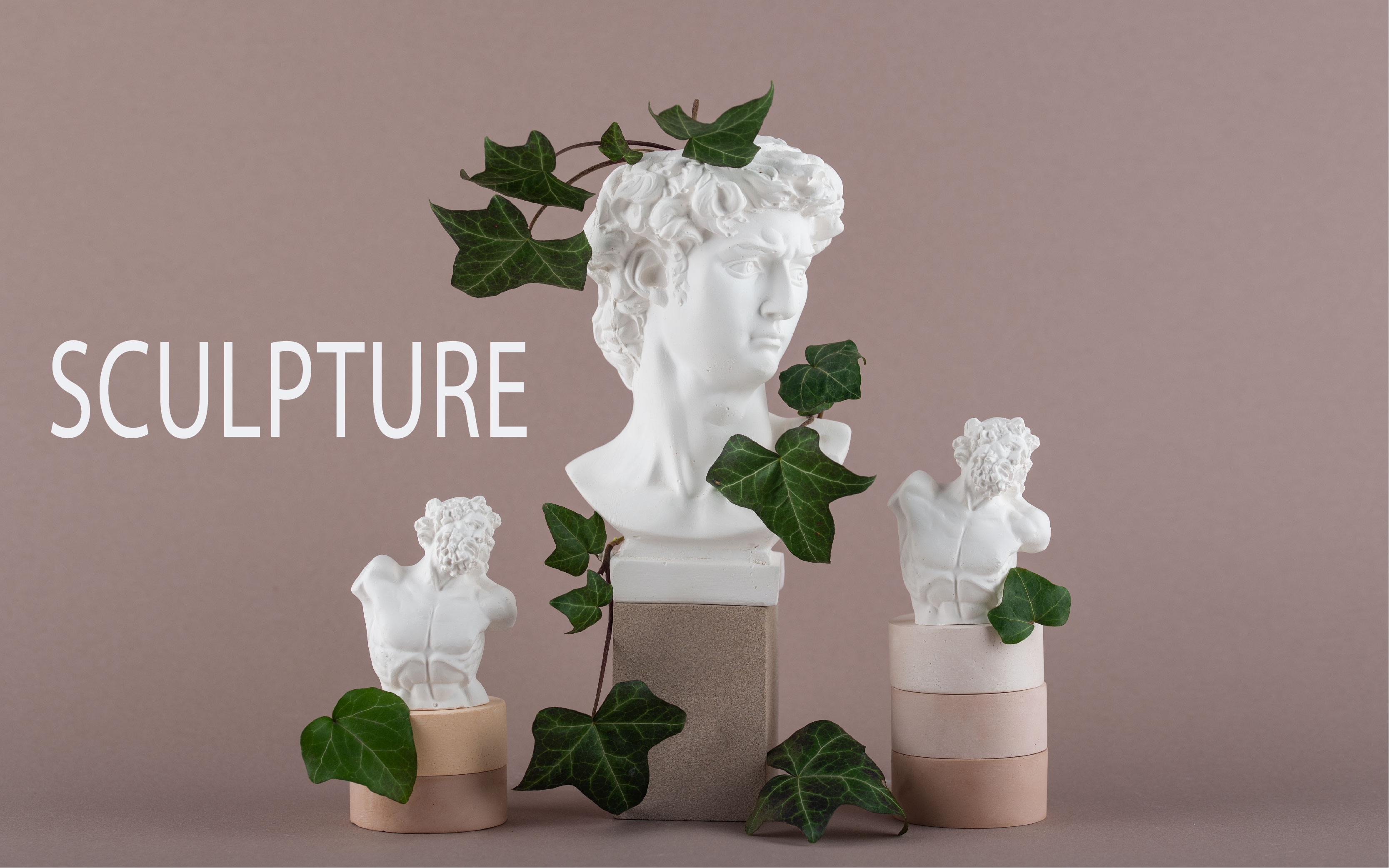Define Sculpture, its Element and Famous Sculptors
Sculpture
is a three-dimensional art form that involves shaping and combining materials
to create a physical object. Sculptures can be made from a variety of
materials, including stone, wood, metal, clay, glass, and even found objects.
Artists use various techniques to manipulate these materials and bring their
creative visions to life. Here are some key details about sculpture: Define Sculpture, its Element and Famous
Sculptors
- Materials:
- Stone: Marble, granite, limestone, and
other stones are commonly used for sculpting. Stone sculptures can range
from small, intricate pieces to large, monumental works. Stone
sculpture is an ancient activity where pieces of rough
natural stone are shaped by the controlled removal of
stone.
- Wood: Sculptors carve, chisel, and shape
wood to create sculptures. Different types of wood offer unique textures
and characteristics. Outdoor wood sculpture does not last long in most
parts of the world, so that we have little idea how the totem
pole tradition developed. Many of the most important sculptures of
China and Japan in particular are in wood, and the great majority
of African sculpture and that of Oceania and other
regions.
- Metal: Bronze, brass, steel, and other metals are
popular choices for sculptures. Most metals are extremely strong, hard, and durable, with a
tensile strength that permits a much greater freedom of design than is
possible in either stone or wood. Metal sculptures can be cast, welded,
or hammered into shape. Gold is the softest and most precious
metal, and very important in jewellery; with silver it is
soft enough to be worked with hammers and other tools as well as cast.
Welding is
a process where different pieces of metal are fused together to create
different shapes and designs. Here are many different forms of welding,
such as Oxy-fuel welding, Stick welding, MIG welding,
and TIG welding.
- Clay: Clay is a versatile material that
allows artists to create both temporary and permanent sculptures. Fired
clay becomes ceramics, while unfired clay can be used for more temporary
works.
- Glass: Glass may be used for
sculpture through a wide range of working techniques, though the use of
it for large works is a recent development. Glass
sculptures are often created through techniques like blowing, casting, or
kiln-forming. Kiln casting
glass involves heating chunks of glass in a kiln until they are liquid
and flow into a waiting mould below it in the kiln. Glass allows for
transparency and unique light effects.
- Techniques:
v Carving: Carving is a
sculptural technique that involves removing material from a larger mass to
reveal a desired form. It is a versatile method used in various artistic
traditions and with different materials. Removing material to reveal the
desired form is a common technique in stone, wood, and some metal sculptures.
Direct Carving:
Description: In
direct carving, the sculptor starts with a block or mass of material and
progressively removes material to reveal the final form. The artist works
directly on the material, responding to its inherent qualities and allowing the
sculptural form to emerge through the act of carving.
Characteristics:
- The process is often intuitive and spontaneous.
- Artists may embrace the natural characteristics of
the material, such as its grain or texture.
- Direct carving is associated with a sense of
immediacy and a hands-on, tactile approach.
- The final result reflects the artist's interaction
with the material during the carving process.
- Applications:
- Stone carving, where the sculptor directly shapes the
stone using tools like chisels and hammers.
- Wood carving, where the artist works directly on a
block of wood using carving knives, chisels, or other cutting tools.
- Modeling in clay, where the sculptor builds up and
shapes the form by directly manipulating the malleable material.
- Famous Examples:
- Constantin Brâncuși's "Bird in Space" is an
example of direct carving in bronze, highlighting the smooth, streamlined
forms achieved through subtractive sculpting.
Indirect Carving:
Description: In
indirect carving, the sculptor creates a model or maquette from a more pliable material,
such as clay or wax. This model is then used to create a mold, and the final
sculpture is produced by casting or other means. The sculptor does not directly
carve the final material but rather works with an intermediate model or mold.
Characteristics:
- The process involves additional steps, including the
creation of a model and the use of molds.
- Allows for the production of multiple copies of the
same sculpture through casting.
- Offers greater control over details and surface
textures during the modeling phase.
- Suitable for materials that are challenging to carve
directly, such as bronze or glass.
Applications:
- Bronze casting, where the artist sculpts a model in
clay, creates a mold, and then pours molten bronze into the mold to
produce the final sculpture.
- Ceramic sculpture, where the artist may create a
model in clay and then use the model to make a mold for slip casting or
other ceramic techniques.
- Glass casting, where a model is made in wax or
another material and used to create a mold for casting glass.
Famous Examples:
- Auguste Rodin's "The Thinker" is an example
of indirect carving in bronze. Rodin created a small model in clay, and
from that, molds were made for the final bronze casting.
v Modeling: Adding material,
such as clay or wax, to build up the form is called modeling. This technique
allows for a more flexible and additive approach. A design modeled in
plastic materials may be intended for reproduction by casting in more permanent
and rigid materials, such as metal, plaster, concrete, and fiberglass, or it
may itself be made rigid and more permanent through the self-setting properties
of its materials (for example, plaster) or by firing.
v Casting: Creating a mold
and pouring a material into it (such as molten metal or liquid plaster) to
produce a replica of the original sculpture. This process allows artists to reproduce a sculpture in multiple
copies. Here are the key steps involved in the casting process:
Creating the
Original Model:
- The artist begins by creating a model of the
sculpture using a pliable material such as clay, wax, or another moldable
substance.
- The model serves as the prototype for the final
sculpture.
Making the Mold:
- A mold is created around the original model to
capture its shape and details. The mold material can be made from various
substances, such as rubber, silicone, plaster, or even metal, depending
on the casting method and the desired result.
- The mold is carefully constructed to ensure that it
captures all the intricate details of the original model.
Preparing the Mold
for Casting:
- Once the mold is complete, it is prepared for the
casting process. This may involve applying release agents or coatings to
facilitate the removal of the final cast.
Assemblage: Constructing
sculptures by assembling found objects or pre-made elements.
- Styles and Movements:
- Classical Sculpture: Influenced
by ancient Greek and Roman art, classical sculpture emphasizes idealized
human forms and naturalistic details.
- Modern and Contemporary Sculpture: Embraces a
wide range of styles and materials, often exploring abstract and
conceptual ideas.
- Kinetic Sculpture: Includes moving parts or
elements, adding an interactive or dynamic dimension to the artwork.
- Famous Sculptors:
- Michelangelo:
Michelangelo was considered the greatest living artist in his lifetime,
and ever since then he has been held to be one of the greatest artists of
all time. A number of his works in painting, sculpture,
and architecture rank among the most famous in existence. Renowned
for works like "David" and the "Pieta."
- Auguste Rodin: Famous for "The Thinker" bronze
sculpture by Auguste Rodin, cast in 1904; in the garden of the Rodin
Museum, Paris. And "The Kiss." Marble sculpture by Auguste Rodin, carved
1888–98; in the Rodin Museum, Paris. “The Metamorphosis of Ovid”, plaster sculpture by Auguste Rodin, c. 1886;
in the Victoria and Albert Museum, London. “Thomas
Fortune Ryan” bronze by Auguste Rodin, 1909; in the Victoria and Albert Museum,
London. “The Gates of Hell”, sculpture by Auguste Rodin, 1880–1917
- Henry Moore: Known for abstract and
semi-abstract sculptures.
- Louise Bourgeois: A prominent contemporary
sculptor known for her emotionally charged works.
- Public Art:
- Sculptures are often displayed in public spaces, parks,
and urban environments as a form of public art. These works contribute to
the cultural and aesthetic identity of a place.



Leave a comment